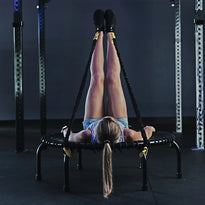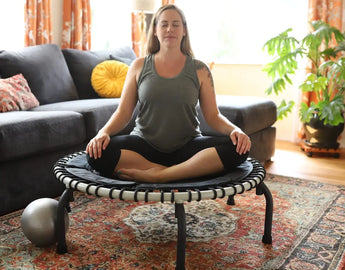Trampoline exercises—often performed on a mini-trampoline or rebounder—are emerging as a creative, low-impact option to support physiotherapy goals. By gently challenging balance, coordination, and strength, rebounding can complement traditional rehabilitation methods and provide an enjoyable workout for individuals recovering from injuries, seniors, and office workers experiencing chronic pain.
Understanding rebound exercises in physiotherapy
Rebound exercises involve controlled movements on a trampoline-like surface that absorbs impact and reduces stress on the joints. This gentle yet dynamic activity offers several benefits:
-
Low-impact aerobic workout: The soft surface minimizes joint stress, making it an ideal exercise for those with sensitive joints or anyone new to physiotherapy.
-
Improved balance and coordination: Regular rebounding helps stimulate the vestibular system, enhancing balance and motor skills—an essential component of any recovery program.
-
Enhanced muscle strength and endurance: Despite the reduced impact, the dynamic movements challenge the muscles, contributing to better lower-body strength.
-
Engaging rehabilitation: The fun, playful nature of rebounding can increase motivation and adherence, which is vital for a successful rehabilitation process.
Evidence supporting trampoline exercises
Recent research underscores the potential of rebound exercises as a valuable addition to physiotherapy. For example, a scoping review by Kulkarni et al. (2024) found that mini-trampoline workouts can enhance blood circulation, oxygen delivery, and bone health—leading to improved lower-limb strength, balance, and overall quality of life (full review on PMC). Similarly, a 12-week randomized trial by Posch et al. (2019) demonstrated that older adults with osteopenia experienced significant improvements in balance, gait speed, and leg strength, effectively reducing their fear of falling (study details on PMC). Complementing these findings, Sadeghi et al. (2024) showed that a 12-week rebound therapy program markedly improved walking speed and stride length in spinal cord injury patients, further solidifying the role of trampoline exercises in enhancing mobility and overall rehabilitation outcomes (access study on PMC).
Practical guidance for incorporating rebound exercises
For those considering adding rebound exercises to their physiotherapy regimen, here are some practical tips to get started:
Safety first
-
Consult a professional: Before beginning any new exercise routine, especially one involving balance challenges, it’s important to consult your physiotherapist or healthcare provider. They can help tailor an exercise program to your specific needs.
-
Invest in proper equipment: Make sure your mini-trampoline is of high quality and equipped with safety features like non-slip surfaces. Adding support handles or safety nets can further enhance stability.
-
Ease into it: If you’re new to rebound exercises, start with low-intensity sessions and gradually increase the duration and complexity as your strength and balance improve.
Choosing the right equipment
When selecting a rebounder, quality and safety are paramount. Reputable companies like JumpSport offer a range of products designed specifically for therapeutic exercise. Their fitness trampolines are engineered with features that ensure a stable and cushioned surface, making them well-suited for physiotherapy programs. Whether you’re incorporating these exercises at home or as part of a clinical program, investing in a high-quality rebounder can make a significant difference in both safety and performance.
Integrating rebound exercises into your routine
-
Warm-up and cool-down: Begin with gentle stretches and a brief warm-up to prepare your muscles. After your session, finish with cool-down stretches to help prevent soreness.
-
Combine with other activities: Rebounding can work well alongside other low-impact exercises such as walking or cycling. This holistic approach can improve overall mobility and balance while reducing the risk of injury.
-
Set realistic goals: Whether you’re aiming to improve balance, reduce pain, or regain strength, setting clear, achievable goals can help maintain motivation. Many rehabilitation programs incorporate these strategies to gradually enhance mobility and function.
Broader implications and long-term benefits
The integration of trampoline exercises into physiotherapy reflects larger trends in healthcare. There is a growing shift toward preventative and holistic care, where maintaining overall wellness is as important as treating specific injuries or conditions. Advances in exercise science and personalized rehabilitation programs have made recovery both more engaging and accessible.
Regular physiotherapy that includes rebound exercises can lead to lasting improvements in mobility, strength, and balance. Not only can these programs accelerate recovery after injuries or surgeries, but they also help reduce chronic pain and improve overall quality of life. This proactive approach empowers individuals to manage their health more effectively and maintain independence over the long term.
Turning insights into action
Rebound exercises offer a fresh, effective way to enhance your physiotherapy program. If this innovative approach to rehabilitation resonates with you, consider exploring additional resources on physiotherapy and wellness. Staying informed about the latest trends and techniques can help you or your loved ones make well-rounded decisions for long-term health.
Engaging with professionals and communities can provide ongoing insights and support. And if you’re curious about integrating rebound exercises into your recovery plan, consider scheduling a consultation with a physiotherapist. A personalized evaluation can help determine if incorporating these low-impact exercises into your routine will bring the benefits you’re looking for.
Embracing rebound exercises as part of your physiotherapy regimen can be a pivotal step toward improved health and well-being. Whether you're overcoming an injury or simply aiming to maintain a balanced, active lifestyle, this innovative exercise method might be the key to achieving your rehabilitation goals.
































